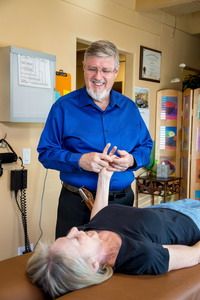 Back pain is not much fun, and yet it is the most common reason people go to doctors. Since most of you reading this newsletter already know how effective non-force Chiropractic care is, we will skip the usual blah-blah about how important it is to see a professional for the proper alignment of your spine for your optimal health. Instead I want to discuss the most common therapy you can do at home to relieve back pain, besides the heat and cold I tell everyone about. That therapy is traction.
Back pain is not much fun, and yet it is the most common reason people go to doctors. Since most of you reading this newsletter already know how effective non-force Chiropractic care is, we will skip the usual blah-blah about how important it is to see a professional for the proper alignment of your spine for your optimal health. Instead I want to discuss the most common therapy you can do at home to relieve back pain, besides the heat and cold I tell everyone about. That therapy is traction.When your back hurts you have either muscle spasm and/or joint swelling 90% of the time. There are the occasions where the back pain is all referred from the gut or the kidneys, or the really rare tumor or cancer of the spine. But the other 90% of the time you are dealing with muscle spasm and joint swelling.
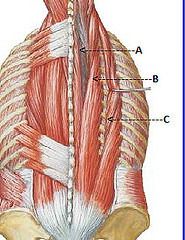
There are seven layers of muscles surrounding your spinal joints. The inner four layers are really tiny muscles that go between the adjacent vertebra for stabilization, minor rotation and lateral bending movements. When these tiny muscles act up and spasm, they squeeze the vertebra closer together causing the joints to get pinched and sometimes the nerves as well. The larger muscles cross several levels of vertebra. When they spasm they not only compress things together, they will also cause torques and bends in the curve of the spine. (photo: ryanmcjohnson / Foter / CC BY)
The heat and cold I recommend to patients brings blood to the layers of muscle and joints to bring in oxygen and nutrition and flush out toxin buildups from the tight muscles. This is a good thing, especially if you add a little magnesium supplementation to the mix, as magnesium acts as a spinal muscle relaxant. Heat the area up first to bring in the oxygen and nutrition. The increased blood flow will increase the joint swelling, so after the heat we use 15 minutes of refrigerator temperature cold to take down the swelling without reducing the blood flow. We don’t use ice over the spine as it will shut down blood flow and create more muscle cramping.
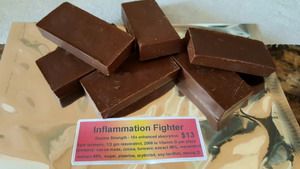
We can also use herbs that reduce inflammation, such as the ones I put into my Inflammation Fighter Chocolate.
This is all well and good, but is there more that we can physically do to relieve the pain? Yes there is – traction. Physically stretching the joints gently apart relieves pressure on irritated nerves and relaxes tight muscles. Sometimes this relaxation alone is enough to break the pain-spasm cycle and relieve the whole problem. Other times we have to change the neurologic feedback loops that have caused the imbalance with non-force adjustments to the spine. Traction is not a cure for the pain, but it can provide relief and support healing of the inflamed tissues. This makes intuitive sense, as our natural impulse when the back hurts is to stretch it to try to relieve the pain.
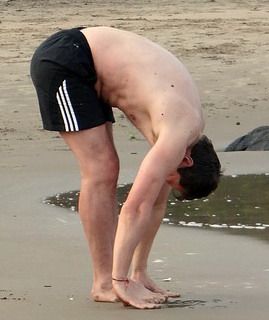 So what does traction look like at home? Some of you may have tried the old trick of leaning on the kitchen counter with your upper body and letting your legs slowly off the ground to stretch the back. I have heard reports of this actually working for a few minutes. A novel variation on this technique was told to me by a patient a couple weeks ago – belly leaning on the tailgate of his 4×4 pickup truck. It worked for a bit. But this is very awkward and uncomfortable to do. The other common one I hear is using forward flexion type yoga postures to stretch open the spine. This is not actually a good idea. A lot of flexion opens the back portion of the spinal joint but squeezes together the front portion of the joint where the disc is. You can actually increase the pressure on the disc three-fold with forward flexion postures.
So what does traction look like at home? Some of you may have tried the old trick of leaning on the kitchen counter with your upper body and letting your legs slowly off the ground to stretch the back. I have heard reports of this actually working for a few minutes. A novel variation on this technique was told to me by a patient a couple weeks ago – belly leaning on the tailgate of his 4×4 pickup truck. It worked for a bit. But this is very awkward and uncomfortable to do. The other common one I hear is using forward flexion type yoga postures to stretch open the spine. This is not actually a good idea. A lot of flexion opens the back portion of the spinal joint but squeezes together the front portion of the joint where the disc is. You can actually increase the pressure on the disc three-fold with forward flexion postures.A little more effective, but equally hard for most people to do, is to simply hang from a chin-up bar from your hands or knees for a couple minutes. This was cool when I was 6 or 7 playing on the monkey bars, but not as comfortable now that I am 62.
 Most of us don’t have $200,000 spinal compression machines in our garage to hop on, but there are other options that are available to us. The least expensive method that will provide gentle traction is our therapy balls. The big balls that we sit on to train our balance muscles can also be used as a passive traction unit simply by draping yourself over the ball belly down and relaxing. The weight of your body will stretch open the joints of the lower back a bit and relax the tight muscles. The ball needs to be blown up fairly tight for this to work properly.
Most of us don’t have $200,000 spinal compression machines in our garage to hop on, but there are other options that are available to us. The least expensive method that will provide gentle traction is our therapy balls. The big balls that we sit on to train our balance muscles can also be used as a passive traction unit simply by draping yourself over the ball belly down and relaxing. The weight of your body will stretch open the joints of the lower back a bit and relax the tight muscles. The ball needs to be blown up fairly tight for this to work properly. The next level of home traction we can use comes in the form of devices designed specifically to traction the spine at home. One of the newest is called the Nubax Trio. It appears easier to use than many other devices for home traction. I have not tried it yet myself, but the videos look promising. You can find it here. Many other devices are sold
The next level of home traction we can use comes in the form of devices designed specifically to traction the spine at home. One of the newest is called the Nubax Trio. It appears easier to use than many other devices for home traction. I have not tried it yet myself, but the videos look promising. You can find it here. Many other devices are sold  for this purpose that have varying levels of ease of use and effectiveness.
for this purpose that have varying levels of ease of use and effectiveness.Of special interest are the devices sold for neck traction. You can still get the old school chin and head strap attached to a rope, pulley, and weight that hangs from a doorway. Find them here. These are pretty uncomfortable to wear. Highly advertised are these inflatable neck collars that look like they stretch out the  neck as the collar fills with air. They have a serious problem however – they jam the jaw joint upward as they fill with air. More sophisticated neck traction (or distraction as it is also called) can be found here called the Posture Pump.
neck as the collar fills with air. They have a serious problem however – they jam the jaw joint upward as they fill with air. More sophisticated neck traction (or distraction as it is also called) can be found here called the Posture Pump.
 neck as the collar fills with air. They have a serious problem however – they jam the jaw joint upward as they fill with air. More sophisticated neck traction (or distraction as it is also called) can be found here called the Posture Pump.
neck as the collar fills with air. They have a serious problem however – they jam the jaw joint upward as they fill with air. More sophisticated neck traction (or distraction as it is also called) can be found here called the Posture Pump.For serious back traction you need to apply a force  approximately equal to half your body weight. This can be achieved at home by either an inversion table or with the Back Bubble. Here is a version of inversion table that starts in a seated position that looks more user friendly than most inversion tables. I like the way the Back Bubble is designed to be able to generate traction with you still in an upright position, as this prevents the rush of blood to the head that always limited how long I could stay on my inversion table. This rush of blood is actually a good thing for a minute or two to improve blood flow to the brain. But anything more than
approximately equal to half your body weight. This can be achieved at home by either an inversion table or with the Back Bubble. Here is a version of inversion table that starts in a seated position that looks more user friendly than most inversion tables. I like the way the Back Bubble is designed to be able to generate traction with you still in an upright position, as this prevents the rush of blood to the head that always limited how long I could stay on my inversion table. This rush of blood is actually a good thing for a minute or two to improve blood flow to the brain. But anything more than  the 5 to 7 minutes I would like to be inverted for my back is simply too uncomfortable. I remember first seeing the Back Bubble at the state fair 20 years ago. It was too expensive for me back then and it just got worse each year after that. Strangely it is less expensive now on Amazon than it was 20 years ago at the fair. Get one here.
the 5 to 7 minutes I would like to be inverted for my back is simply too uncomfortable. I remember first seeing the Back Bubble at the state fair 20 years ago. It was too expensive for me back then and it just got worse each year after that. Strangely it is less expensive now on Amazon than it was 20 years ago at the fair. Get one here.
 approximately equal to half your body weight. This can be achieved at home by either an inversion table or with the Back Bubble. Here is a version of inversion table that starts in a seated position that looks more user friendly than most inversion tables. I like the way the Back Bubble is designed to be able to generate traction with you still in an upright position, as this prevents the rush of blood to the head that always limited how long I could stay on my inversion table. This rush of blood is actually a good thing for a minute or two to improve blood flow to the brain. But anything more than
approximately equal to half your body weight. This can be achieved at home by either an inversion table or with the Back Bubble. Here is a version of inversion table that starts in a seated position that looks more user friendly than most inversion tables. I like the way the Back Bubble is designed to be able to generate traction with you still in an upright position, as this prevents the rush of blood to the head that always limited how long I could stay on my inversion table. This rush of blood is actually a good thing for a minute or two to improve blood flow to the brain. But anything more than  the 5 to 7 minutes I would like to be inverted for my back is simply too uncomfortable. I remember first seeing the Back Bubble at the state fair 20 years ago. It was too expensive for me back then and it just got worse each year after that. Strangely it is less expensive now on Amazon than it was 20 years ago at the fair. Get one here.
the 5 to 7 minutes I would like to be inverted for my back is simply too uncomfortable. I remember first seeing the Back Bubble at the state fair 20 years ago. It was too expensive for me back then and it just got worse each year after that. Strangely it is less expensive now on Amazon than it was 20 years ago at the fair. Get one here.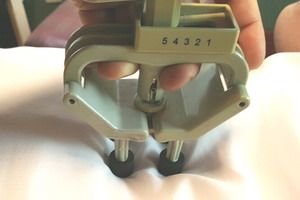 The last option for traction is what I use in the office – the Disc Pump. This is not something you can use at home, but it gives you an idea of what an ideal traction device looks like. The advantage to what I use is that it is exactly specific in its application. I put it right on the joint space I want to open and it holds the area open for exactly the amount of time I need. It pulls apart the vertebra in such a way that it is able to help suck bulging discs back into place. Along with the adjustment and muscle balancing, we can often relieve some pretty serious back problems.
The last option for traction is what I use in the office – the Disc Pump. This is not something you can use at home, but it gives you an idea of what an ideal traction device looks like. The advantage to what I use is that it is exactly specific in its application. I put it right on the joint space I want to open and it holds the area open for exactly the amount of time I need. It pulls apart the vertebra in such a way that it is able to help suck bulging discs back into place. Along with the adjustment and muscle balancing, we can often relieve some pretty serious back problems. But back to home therapy units. Personally I love Amazon for getting things like these. I have always been a shopper – meaning I have to check out every store in town for an item to get the best deal. I save a fortune in time and gas now that I shop on Amazon. The above links and pictures all go to Amazon in case you want to buy something there.
So here is one more tool for you to care for yourselves and keep yourselves as pain free as possible.
